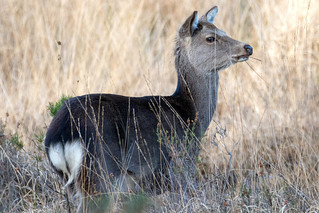Half term and off to visit my daughter in Bournemouth. We have had the opportunity to try out a few B&Bs over the last three years and we have settled on one which is out of town on the edge of Poole / Sandbanks, almost opposite the top of Branksome Dene Chine.
Last October we were lucky enough to spot firecrest a hundred or so yards  down from the top of the Chine so on this visit it was only natural to have another look - in fact we made it a daily visit on our way down to the promenade for our morning stroll and coffee.
down from the top of the Chine so on this visit it was only natural to have another look - in fact we made it a daily visit on our way down to the promenade for our morning stroll and coffee.
Happily we were not disappointed and were able to watch these birds flit from tree to bush, hardly stopping long enough for me to get off any photos. However, with the new camera body [Nikon D7500] and the greater tolerance to low light (ISO settings) allowed me to take some photos at 1/500 thus avoiding much blur.  I am very happy with the results and have been surprised by the positive response on Twitter.
I am very happy with the results and have been surprised by the positive response on Twitter.
Mid-morning we picked up our daughters and drove over to Mortons House Hotel at Corfe Castle in Wareham for lunch. As usual, the triple decker BLT was popular. We didn’t stay long as we were off to RSPB Arne for a walk around.
Arriving at the reserve, the main car park was full and we  were immediately directed to the overflow car park. This suited us as we had decided that we would follow the Coombe Heath trail, as we had in February 2017. We walked round in a clockwise rotation stopping at the first screen. From here we could see Brent geese on the water and the fields beyond, redshank, avocet, shelduck, and had a spoonbill fly over. We continued onto the hide and from here could appreciate the numbers of avocet present - a few hundred rather than the 500 last time. We also added curlew, dunlin and black-tailed godwit.
were immediately directed to the overflow car park. This suited us as we had decided that we would follow the Coombe Heath trail, as we had in February 2017. We walked round in a clockwise rotation stopping at the first screen. From here we could see Brent geese on the water and the fields beyond, redshank, avocet, shelduck, and had a spoonbill fly over. We continued onto the hide and from here could appreciate the numbers of avocet present - a few hundred rather than the 500 last time. We also added curlew, dunlin and black-tailed godwit.
 Coming off of the estuary path we saw a single white doe off to the right - sika deer - and then two more in the gorse to the left. Despite looking we couldn’t locate any dartford warbler. Another couple of doe sika deer on the return trail before heading to the reserve cafe for drinks.
Coming off of the estuary path we saw a single white doe off to the right - sika deer - and then two more in the gorse to the left. Despite looking we couldn’t locate any dartford warbler. Another couple of doe sika deer on the return trail before heading to the reserve cafe for drinks.
On the way back to the car we stopped off at the feeding station as they were closing up the hut. Charlotte had seen nuthatch earlier (but I hadn’t) but it stayed away - the consolation prize was a single male siskin on the feeders.
This really is a good place to visit and I’ll likely be back if not just to find dartford warbler later in the season.
Sightings (30) included: avocet, black-headed gull, black-tailed godwit, blackbird, blue tit, brent goose, carrion crow, chaffinch, coal tit, cormorant, curlew, dunlin, dunnock, great tit, kestrel, lapwing, little egret, long-tailed tit, magpie, mallard, mistle thrush, pied wagtail, redshank, robin, shelduck, siskin, spoonbill, teal, wigeon and woodpigeon.



